Wartburg Castle is located in Eisenach, in the eastern part of Germany, about 83 km from the town of Weimar. Wartburg Castle is situated on a steep forested hillside. Wartburg Castle was founded in 1067, only some small parts from this period have survived. Wartburg Castle has been renovated and overbuilt throughout its existence. In the 19th century, Wartburg Castle was reconstructed and restored to its original Romanesque style. The Luther Room was also renovated, the room has its original floor and paneled walls. From May 1521 until March 1522, Martin Luther stayed at the Wartburg. It was during his exile at Wartburg Castle that Martin Luther translated the New Testament from Greek into German. The Textus receptus, the first printed Greek New Testament edited by the Dutch humanist Erasmus, was the translation base for the first New Testament in German. The Elizabeth Kemenate (room) is dedicated to Elizabeth of Hungary. Elizabeth lived at the Wartburg Castle from 1211 until 1228. She was renowned for her charitable work and canonized a saint by the Roman Catholic Church. The renowned poet and novelist Goethe spend five weeks at the Wartburg in 1777, he made numerous drawings and sketches of the castle. King Ludwig II of Bavaria was inspired by Wartburg Castle, it served as an inspiration for numerous rooms and details at Neuschwanstein Castle, Germany's most famous castle. Wartburg Wartburg Castle was declared a UNESCO World Heritage in 1999.
www.werelderfgoedfotos.nl © Copyright World Heritage Photos
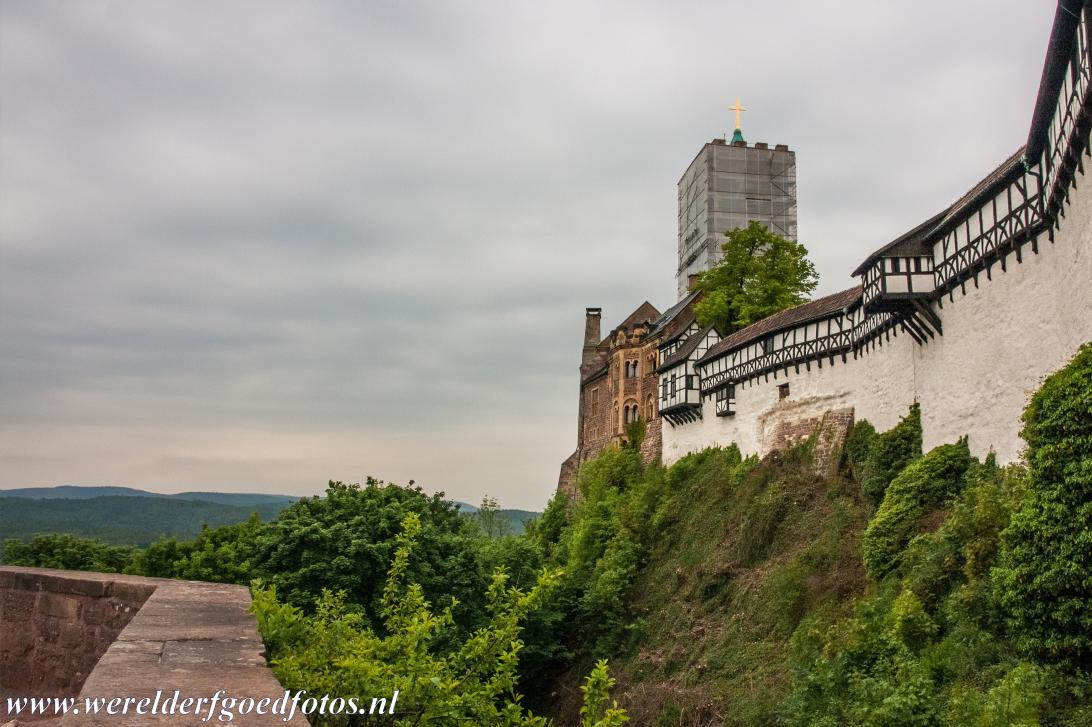
Wartburg Castle was founded in 1067. The castle is situated on a steep forested hill close to the German town of Eisenach. The castle is surrounded by the Thuringian forest. The castle was an important centre of power during the Middle Ages and the seat of the Landgraves of Thuringia. The most famous resident of the Wartburg was the theologian and reformer Martin Luther.

Wartburg Castle was founded in 1067. The castle is situated on a steep forested hill close to the German town of Eisenach. The castle is surrounded by the Thuringian forest. The castle was an important centre of power during the Middle Ages and the seat of the Landgraves of Thuringia. The most famous resident of the Wartburg was the theologian and reformer Martin Luther.
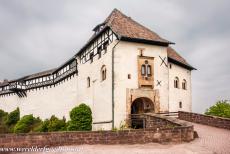
Wartburg Castle: The Gatehouse was built in 1150. The Wartburg is only accessible via a small drawbridge and the Gatehouse. Wartburg Castle has been renovated and overbuilt throughout its existence. The oldest and most original parts of the castle are the Palas, the Gatehouse and the South Tower, much of its interior dates back to the 19th century.
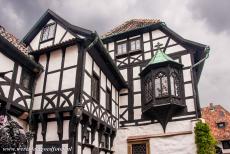
Wartburg Castle: The 15th century oriel of the Vogtei, the bailiff's offices. The Vogtei is a part of the Vorburg (bailey), situated in the first courtyard, dating back to the 14th and 15th centuries. The Luther Room is situated in the half-timbered Vogtei, on the wall of this renowned room is a portrait painted by Lucas Cranach the Elder, the painting depicts Luther disguised as Junker Jörg.
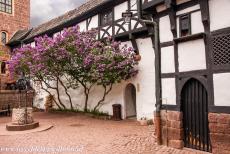
Wartburg Castle: In the corner of the courtyard stands a small castle well. The castle had its own water supply, this was very important, especially when under siege. A large cistern is situated in the second courtyard. Inside the castle walls, the Wartburg had also a kitchen garden. Wartburg Castle was inscribed on the UNESCO World Heritage List in 1999.
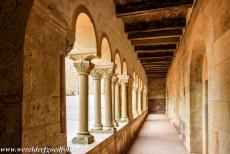
Wartburg Castle: One of the colonnades in the Palas. The Palas is the 12th century palace. The Romanesque Palas is the oldest part of Wartburg Castle, the Palas is the largest structure of the Wartburg. It houses rooms, such as the Elizabeth Room, the Knight's Room and the Singers' Hall. The interior of the Palas was restored in the 19th century.
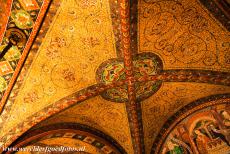
Wartburg Castle: The Elisabeth Kemenate (room) is adorned with coloutful mosaics, the mosaics consists of more than a million tiny pieces of glass, gold leaf tiles and mother-of-pearl. Elizabeth of Hungary was the wife of Ludwig IV, Landgrave of Thuringia. The Elisabeth Kemenate was the room where she lived. The Elizabeth Room is completely covered with mosaics.
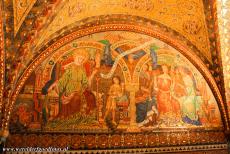
Wartburg Castle: The Elizabeth Room is dedicated to Elizabeth of Hungary, she lived at Wartburg Castle from 1211 until 1228. The colourful mosaics depict the short life of Elizabeth of Hungary. She was renowned for her charitable works. She died at the age of 24 and soon after her death canonized as a saint by the Roman Catholic Church.
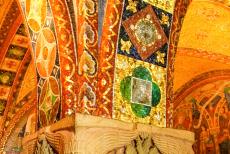
Wartburg Castle: Even the columns in the Elizabeth Room are decorated with mosaics. The last German emperor, Kaiser Wilhelm II, ordered the Elizabeth Room to be decorated. The mosaics were designed and created by the German artist August Oetken in 1902-1906, he decorated the walls, vaults and columns with amazing Neo-Byzantine style mosaics.
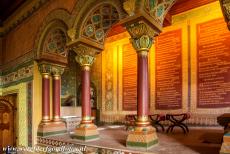
Wartburg Castle: The Rittersaal is the Room of the Knights, the room is situated in the Palas, the oldest part of the castle. The Room of the Knights was restored to its original Romanesque style in 1854. The wall paintings depict the story of Wartburg Castle. Goethe spend five weeks at the Wartburg in 1777, he made numerous drawings and sketches of the castle.
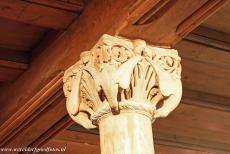
Wartburg Castle: An original Romanesque carved stone capital in the Palas. There are about 200 carved capitals in the Palas, a third of them are original masterpieces of Romanesque sculpture. The Palas is one of the few remaining Romanesque palaces north of the Alps, it was restored in the 19th century, several elements in the Romantic style architecture were added.
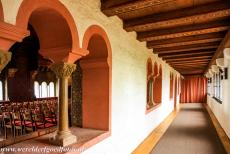
Wartburg Castle: On the left hand side the decorated Singers' Hall. During the Middle Ages, the castle was a centre of arts and music. Wartburg Castle was the location of the Minstrel Contest, the Sängerkrieg, or the Wartburg Song Contest in 1207. The German composer Richard Wagner based his opera Tannhäuser on this legendary song contest.
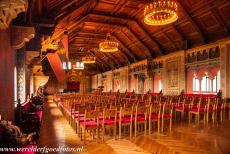
Wartburg Castle: In the Singers' Hall, the legendary Minstrels' Contest of Wartburg Castle took place in the Middle Ages. Nowadays, the Singers' Hall is regularly used for the performance of the opera Tannhäuser, the full title: Tannhäuser und der Sängerkrieg auf Wartburg. Wartburg Castle inspired Ludwig II of Bavaria to build his fairytale castles, such as Neuschwanstein.
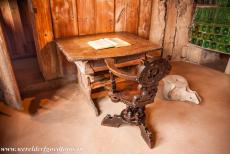
The Luther Room, the Lutherstube, is the most famous room in Wartburg Castle, from May 1521 until March 1522, the reformer Martin Luther stayed at Wartburg Castle. In the Luther Room he translated the New Testament into commonly spoken German, he was not the first translator of the Bible, but the Luther Bible became widely known due to the invention of the printing press.
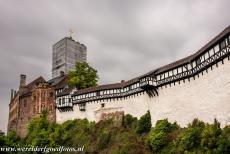
The Bergfried is the donjon of the Wartburg, the tower was completed in 1859. During the nazi regime, the cross on the Bergfried was replaced by a swastika. Hitler was a great admirer of the Wartburg, he called it 'the most German of German castles'. Wartburg Castle gained the status as a UNESCO World Heritage in 1999.
